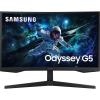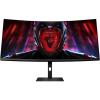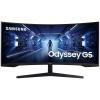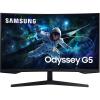If you're shopping for a new gaming monitor or trying to make sense of the specs on your current one, you’ve probably come across terms like G-Sync and FreeSync. Both are technologies that help smooth out your gameplay, but they’re not the same, and not every monitor supports both.
Here’s what they mean, how they differ, and whether or not you really need them.
Why Screen Tearing Happens
Before jumping into G-Sync and FreeSync, it helps to understand the problem they’re solving, screen tearing.
Screen tearing happens when your monitor's refresh rate and your graphics card’s frame rate are out of sync. You might notice horizontal lines where the image looks like it’s been split or misaligned. This usually happens in fast-paced games when the GPU is sending frames faster (or slower) than the monitor can handle.
That’s where variable refresh rate (VRR) technologies like G-Sync and FreeSync come in.


What Is G-Sync?
G-Sync is NVIDIA’s adaptive sync technology. It allows the monitor’s refresh rate to dynamically match the frame rate of your NVIDIA graphics card. When both stay in sync, gameplay feels smoother and screen tearing is reduced or eliminated.
Originally, G-Sync required special hardware inside the monitor, which added to the cost. These monitors were called “G-Sync certified” and had a proprietary NVIDIA module built in.
However, newer versions such as G-Sync Compatible use industry-standard adaptive sync, meaning they no longer require extra hardware. Instead, NVIDIA tests and certifies monitors that meet their performance standards.
Best with:
- NVIDIA graphics cards
- High frame rate games where stability is key
- Gamers who want the most seamless NVIDIA ecosystem
What Is FreeSync?
FreeSync is AMD’s version of adaptive sync. It does the same job — syncing the monitor’s refresh rate with the GPU’s output — but it’s open-standard and built on DisplayPort Adaptive-Sync and HDMI VRR.
Because it’s royalty-free, FreeSync monitors tend to be more affordable. Many monitors support FreeSync by default, especially at midrange and budget levels.
FreeSync also has different tiers:
- FreeSync – Basic support for variable refresh
- FreeSync Premium – Includes support for low frame rate compensation (LFC)
- FreeSync Premium Pro – Adds HDR tone mapping and more for high-end displays
Best with:
- AMD graphics cards
- Budget or midrange gaming builds
- Gamers who want adaptive sync at a lower price point
Are They Compatible Across Brands?
This is where things get slightly more technical.
- NVIDIA GPUs work with G-Sync and G-Sync Compatible monitors.
Newer NVIDIA cards can also work with some FreeSync monitors, but not all are guaranteed to perform well. - AMD GPUs work with FreeSync monitors.
AMD does not support G-Sync hardware modules, but many G-Sync Compatible monitors will still work via basic adaptive sync.
If you’re mixing brands — like using an AMD GPU with a G-Sync monitor — check the monitor specs and community feedback to confirm compatibility.


Is It Worth Having G-Sync or FreeSync?
For most gamers, yes — having one of these technologies makes a noticeable difference. You’ll get smoother gameplay, reduced tearing, and fewer visual stutters. It becomes especially important in games with fast movement, like first-person shooters or racing titles.
If you’re gaming at 60Hz or lower, or you lock your frame rate consistently, the difference might not be as dramatic. But once you move into higher refresh rates (120Hz and up), it becomes much more important to keep things synchronised.
Do You Need a Monitor with It?
Not always, but it’s highly recommended if:
- You play competitive or fast-paced games
- You have a graphics card that varies frame rate output
- You want the smoothest experience without enabling V-Sync, which can introduce input lag
If you mostly browse, watch media, or play slower-paced games, it’s not essential, but still nice to have.
Final Thoughts
G-Sync and FreeSync are both designed to give you smoother, tear-free gameplay by syncing your monitor’s refresh rate with your graphics card’s output. G-Sync works best with NVIDIA cards, while FreeSync is the go-to for AMD setups.
You don’t strictly need one to enjoy gaming, but if you’re investing in a quality monitor, especially at higher refresh rates, it’s well worth having. Just make sure the monitor you choose matches your graphics card for the best results.






